Let’s talk...
About desires and feelings: The girl wanted a shiny bag decorated with planets, but she got another bag which made her angry. We can follow the angry child’s behavior in the story, and ask our child: How did the child express her anger? How did she behave with her classmates? How did her feelings change? Was the bag really terrible? How did her view of it change?
About similar experiences: We can talk to our child about experiences similar to the story. We can ask them: Has it happened that you strongly desired something, like the child in the story, and got something else? How did you feel? How did you behave?
Let’s enrich our language...
The story is rich with words and terms from the world of space, such as: planet, star, galaxy, space dust, Halley’s comet, spaceship, and many other terms. Let’s search for them in the story together.
Let's imagine...
The cardboard box became a spaceship; let’s imagine and complete the following sentence: This is not a box but it could be…..
Let’s create...
We can recycle some cardboard and shoe boxes at home, and make new toys such as: a spaceship, doll houses, a jewellery box, a car and others.
Let's research...
We can visit a museum that displays information about space, or watch a family movie about space.
Discuss...
The importance of books: Anwar noticed some changes in town when the books disappeared. Talk to your children about the changes and why they believe these changes occurred.
The love for reading: Anwar loved reading. He was sad when the mayor tore up the books. Ask your children: How does Anwar feel when he reads? How do you feel when you read or listen to a story?
The types of books our children prefer: The text indicates different kinds of books (story, poetry, cookbook). Talk to your children about book types they know and are in the libraries. Ask them: Which books do you like? Why?
Creativity and imagination: Anwar succeeded in creating and publishing books for people in town, influencing their lives. Ask your children: Where, in their opinion, does the idea of a book come from? How did Anwar write his books? Support and talk to your children about their experiences and stories they may want to write.
Explore...
Visit your town’s public library and search, with the children, for books they love.
Enrich your language...
Enrich your child’s lexicon with the names of new plants: dandelion, red maple, and willow. Which flowers/wild trees can we see in abundance in our country?
Create...
Together with your children, enjoy the book’s drawings. The drawings are made with the collage technique and include fine details that provoke laughter or sadness. The collage is comprised of newspaper clippings in several languages and strange illustrations.
Let’s talk...
About desires and wishes: Mountain wanted to see the sun, but he couldn’t. We can talk to our child about the things they want and desire: which things can they have, and which are hard for them to get? How do they feel? We can think together and suggest different ways to fulfill our desires.
Feelings: We can follow the drawings with our children and talk about the various feelings of Mountain and his friends. We can name them and ask the children about their causes, such as: feelings of frustration when he could not see the sun; feeling excited; Sympathy from friends. We can connect feelings to their effect on our behavior.
Solving problems: Mountain’s friends tried to deal with his problem by suggesting several solutions. We can talk with our children about the solutions that his friends have suggested and offer others that they have not. We can train our children to be flexible, creative outside-the-box thinkers.
Helping and Cooperating: Mountain’s friends sympathized with him and tried to fulfill his desire to see the sun. We can ask our children: Did anyone help them get something they wanted? Then we can also ask: Who supported them? How did they feel?
Let’s play and imagine...
We can choose an object, think outside the box, and suggest many uses for it beyond the well-known traditional use.
Let’s act and innovate...
We can train our children to think flexibly by suggesting issues and problems that our child faces in daily life and searching for and acting out many solutions.
Let’s explore...
We can go out to nature with the family to observe the mountains and witness their beauty and the life of the creatures living there.
Together, you can...
Together, you can discuss what the crow, the turtle, and the mouse each did to save the deer from the trap. Could the deer have been saved without their cooperation?
Recall an incident...
Recall an incident at home or in your neighborhood where people cooperated to help someone. What did each one do? In addition, what did our child do? It is time to talk about the role of every one, even if it is a small role.
The story starts...
The story starts with an illustration of the friends playing chess. Maybe it can encourage us to play chess with our child.
How about a theater...
How about a theater show of the mouse and his three friends? We can make masks of each character and play the story. Who will play the hunter role?
Hunting deer...
Hunting deer is illegal in our country because deer is an endangered species. It is time to talk about hunting wild animals. Why do some people would want to hunt? Maybe we can learn about endangered species with our children and what animals it is illegal to hunt in different parts of the world.
What do you think...
What do you think the new adventure of the three friends will be the next day? We can encourage our child to use his/her imagination and make up a story about another adventure the three friends might have.
Look through the...
Look through the book together and examine the unusual illustrations that accompany the text. Notice the various perspectives the illustrator used in creating these pictures. Which pictures show the action from above—and which from the side? Talk with your children and ask them why they think the illustrator chose to portray the events on the bridge as she did.
Sometimes, before we...
Sometimes, before we arrive at a good idea, we first have to try (and discard) some not-so-good ideas. Together with your children, go back over the various solutions which the bear and the giant proposed in the story. What are the upsides and downsides of each idea?
Do you remember...
Do you remember the game of “Golden bridge”? Stand opposite your child and hold both his hand high to form a bridge. Invite other family members and friends to pass under the bridge, while singing: “Oh Golden bridge, Oh golden bridge/ we all pass under you and someone will be caught”. Whoever is passing the minute you say “caught” is out.
Let’s have a conversation...
Let’s have a conversation about feelings: We can follow the feelings of the mole and the wolf with our children. We can name them and discuss the reasons for why they felt this way.
Let’s have a conversation about personal space: Mole liked his personal space. He loved his house, his bed, the smell of dirt and the darkness around him. We can ask our children about their favourite place/corner: Why did they choose it? What do they like to do on their own?
Let’s have a conversation about dealing with problems and overcoming fear: The mole and the wolf were lost and strayed away from their homes, but they were able to support each other and return safely. We can discuss the following with our children: How do we feel when we are lost? And how should we act? We can listen to them and direct them on how to act.
Let’s have a conversation about the formation of friendship: The mole and the wolf are two different animals, but they were able to become friends when they felt and supported each other. We can ask our children: How do the mole and the wolf resemble their friends and how are you different from them? What does it mean to feel the other or sympathize with him? How did the mole and the wolf support each other, and how did they become friends? Have they ever felt sympathy for their friend, or has someone supported them and become their friend?
Let’s act...
Let’s act getting Lost: We give our children a similar scenario that the mole and the wolf faced, and we act out how we would act if we got lost. We can take turns with our children, give them a model to deal with the problem, and talk to them about it.
Let’s enrich our language...
Let’s enrich our language The story is rich in vocabulary such as: humming; heaped, dazzle, horizons; etc. We can explain them to our children before reading and immediately after reading them in the text.
Mental and emotional dictionary: the story contains mental vocabulary, such as: imagination; decided; realized; fake/unreal. It contains emotional vocabulary, such as: poetry; in love; amazed; fear; feeling reassured and confident. It is important that our child acquire these new words and can use them in their daily life to describe and express emotional states and ideas, and to facilitate their use during dialogue.
Let’s play together...
Let’s use a blindfold: The wolf and the mole played in the dark and had fun. We can blindfold ourselves and play a game where we search for our children when blindfolded while our children try to escape from us.
Let’s explore...
Let’s explore Mole’s Life: The mole is a special animal that lives underground. We can search with our children for information on the Internet or encyclopaedia about it (you can explore other animals featured in the story as well).
The Blind: We can suggest to our children to put themselves in a blind person’s shoes, to sympathize with them and describe their feelings and the challenges they face.
Let’s communicate...
We invite our child’s friends to visit our home, and we contribute to strengthening our child’s social relationships.
We can discuss...
About the title: We can discuss the title of the story “The Cow that Laid an Egg,” and we can ask the children: Does the cow lay eggs?
We can ask...
About the concept of the unique and the special: We can ask the children: What is meant by unique and special? What are things that are common and normal? What are the special things that distinguish us and that we do differently? When do we feel special? Has anyone given us that feeling? Do we do things that make others feel special?
About trickery...
About trickery: The chickens used a trick to support the cow. What is the trick? Why did the chickens use it? What did the characters in the story think about it, and how did each of them feel? We can follow the drawings and talk about them. We can ask the children: Did they ever use a trick? How? Why? How did they feel?
A Fun night...
“A Fun night” – we can arrange a family session, grab a book of jokes, laugh and have fun together. We can also come up with some funny jokes and stories.
We can write...
We can write a funny book adapting the collage style by using newspaper clippings and colors to create funny scenes, such as sticking a chicken’s head on a cat’s body – for example.
We can browse...
We can browse the encyclopedia, or the Internet, and search for different animal species and how they breed.
We can look...
We can look for videos showing the stages of egg hatching. We can watch it and talk about it with the kids.
We can chat...
We can chat about how Edward the giraffe feels about his neck. Why did he feel like this? What helped him accept his neck and see its benefit?
We can think...
What do we like about animals? We can think of different animals, and take turns completing this sentence: What I love about the elephant/the dog/the ant is…because…
We can talk...
We can talk to our child about the qualities they do not like and that bother them about themselves. It is important to support the child in seeing what these characteristics allow (for example: being small in size enables them to enter confined spaces). We can also talk about other qualities that they love about themselves.
Turtle helped Edward...
Turtle helped Edward the giraffe to love his neck. Which friend makes us feel loved? Which friend makes us feel happy?
We can look...
We can look in the mirror and describe what we see: short straight hair/wide brown eyes…
Edward is in...
Edward is in our house! We can create a model for Edward’s neck from a long cardboard cylinder, and search our wardrobes for different ties that we can we can wrap around it.
Super Phil can...
Super Phil can fly in the sky, Aunt Zelda is a brilliant seamstress, and Filo is brilliant in devising tricks. We talk about the things that our child does brilliantly and that make him “super”.
We imagine that...
We imagine that the two elephants come across a herd of giraffes, or a group of bears, or frogs in the puddle. Which tricks may Filo devise to bypass the animals?
We think about...
We think about why illustrator drew Filo and Aunt Zelda in different colors while he drew the other elephants in gray.
A family workshop...
A family workshop to design fashion that makes us with superpowers! We need old clothes, fabric dyes, and some small pieces for decoration like buttons, feathers, shiny fabrics, etc.
With a child...
With a child, we can follow the dot’s “trip” on a piece of paper, and connect it to other dot that create shapes; we can play with the shapes to build house and human beings
We can draw...
We can draw or stick several dots on paper, and ask our child to connect between them. Then, we can ask whether the dot could create such shapes if it stayed alone. We can have a conversation with the child about the importance of cooperation at home and at the kindergarten.
We can look...
We can look for items at home or outside that are made of lines, circles, and squares – a carpet or the borders of a yard. We can catch the child navigate the child around as if he/she were a train among these different shaped items and ask him to call out what shapes we are passing (circle, square, triangle). We can also look for small shapes at home among the child’s games that have simple geometrical shapes.
Build and dismantle...
Build and dismantle! We can use cotton wool tips (the kind we clean our ears) to build unlimited number of shapes.
We can cut...
We can cut out squares, circles, triangles and rectangles, and ask the child to build shapes
We can draw...
We can draw on a paper a simple shape (such as a circle, a square, a straight line etc…) and ask the child to imagine the things we can create from these shapes. We can have a conversation about what shapes are need to build an item the child thinks of, and help him/her to draw it.
Baked shapes...
Baked shapes! All we need is to prepare some cookie dough, create shapes, and add some sweets to decorate them. Enjoy!
We can encourage...
We can encourage our child to read the letters aloud, and to think of another animal, to whom the mailman shouts: “Hi…. a letter for you!” Who is the sender? What could the letter contain?
The mailman is...
The mailman is lonely even though he is busy all day delivering letters. We can talk about what it means to be alone. How does he feel? Do we sometimes feel alone? when?
We can think...
We can think of someone we know who we feel is alone. How can we make them feel less lonely? We might visit them more often, bring them food they love, accompany them on a picnic, or do something that entertains them and makes them happy.
We can talk...
We can talk about the different types of letters that people exchange, from paper to electronic messages, and about the methods of exchanging letters throughout the ages. It would be fun to take our child to the post-office so we can check our letters together, and send another one.
Mom, a letter for you...
“Mom, a letter for you!” Together we can design a mailbox from cardboard for our house, and write letters for each other. Sometimes it is easy for us to write down what we find difficult to say, and we may enjoy short letters full of thanks and affection.
The mailman’s forest...
The mailman’s forest is full of exotic animals. We may want to get to know them with our child.
How did the letters...
How did the letters get to the mailman’s bag? Together, we can follow the little mouse as we look at the beautiful illustrations of this book.
We can chat...
We can chat with our child about the emotional block that Elba is dragging. What does it consist of? Do we sometimes feel like we’re dragging a similar one? when?
Together, we can...
Together, we can recall what Norris did with Elba to ease her grief and reduce the weight of the block that she was dragging. We can encourage our child to think of other ways that Norris supports Elba.
We may want...
We may want to talk about a similar experience in our family. How can we support each other in times of trouble and sadness?
The book is...
The book is entitled “Maybe Tomorrow.” We can try to think of different possibilities to complete the sentence.
We can look...
Together, we can look at the last drawing in the book, and compare it with Elba’s drawings on other pages. What is different about it?
Together, we can...
Together, we can look at the cover of the book, and talk about the meaning of “trouble” in the title by looking at the expressions on the faces of the Simsim family.
We can recall...
We can recall the reactions of every friend who hosted the Simsim family. What would we do if the family needed our help? We can try to remember an experience where we hosted a family, some relatives or friends. What made us happy, and what bothered us?
Our family may...
Our family may be one of the families that moved once to a temporary residence – perhaps to the house of a relative or friend – due to repair work in the house, or a long trip, or otherwise. With our child, we can recall this experience: What did they miss at home?
Let’s get to know...
Let’s get to know the members of the Simsim family: the rabbit, the lizard, the scorpion, the mole, and the jerboa. Where do all of them live?
The drawings...
The drawings of the story convey the feelings of the characters in an accurate and expressive way, such as anxiety, fear, sadness, and joy. We can look at the characters’ faces and their body movements. How do we express these feelings with our bodies?
At the beginning...
At the beginning of the story, the other fish greet Caspion with nice words (hello, good morning, how are you?) We can chat with our child about phrases that we use to greet others.
The fish express...
The fish express how proud they are of Caspion with phrases such as: you are amazing, one of a kind, etc. Which phrases would our children prefer us to use to encourage them? We might want to write them down on small pieces of paper, and put them among their things: in their bag, or in their closet, or stick them on the mirror in their room.
Caspion is attacked...
Caspion is attacked by the shark, so she runs away, screaming for help. What would we do if we were in danger?
The whale rescues...
The whale rescues his friend by using his physical strength. We can talk with our child about situations in which they rescued a friend or relative using their physical strength, their intelligence, or other skills.
There is a special...
There is a special friendship between Caspion and the big whale, despite the difference in their size. We can talk with our child about friendships that they or we have with people who are different from us. What do we like about their friendship?
We can explore...
We can explore marine life in the story. Which other creatures does our child know? They may want to draw them.
We can go...
We can go on a visit to an aquarium or an ocean/maritime museum. This could be an exciting activity for all family members. Buckle up and let’s go!
We can talk...
We can talk with our child about the different feelings that Mint experiences. When does she feel angry, when does she feel down, and why? Do we sometimes have similar feelings? when?
We can chat...
We can chat with our child about what Mint could have done every time her drawing was destroyed. This helps our child to see alternative ways to solve a specific problem.
Sometimes our child...
Sometimes our child feels frustrated when they try to do something beyond their capabilities at that age. We may want to have a conversation with them about things that they can do, and things they were not able to do last year (such as: riding a two-wheel bike, walking to the nearby store alone, etc.)
What do they like...
We can chat with our child about their relationship with their older or younger siblings, or their relationship with another child in the extended family. What do they like about each brother/sister? What makes them upset about his/her behavior? What things do they enjoy doing with their siblings?
Big brother/sister’s...
“Big brother/sister’s room is always nicer!” A phrase we hear often from our young children. We can chat with our child about what they like in the older sibling’s room, and what they like in their own room. Together, we can think of simple ways to make their room a more comfortable and enjoyable place for them (maybe we decide to paint a wall with a nice color, or hang some pictures on it …)
A paper-cutting workshop...
A paper-cutting workshop! We can encourage our child to fold some papers and to trim the edges in a different way each time. What shapes do we get?
This flip book...
This flip book, which is the first of its kind in the Lantern Library, provides children the ability to guess what is hiding under the cover. We can stop at each cover and encourage our child to guess what is underneath. In repeated readings of the book, we can encourage the child to recall the details of the hidden drawings. For example, what does the hidden animal do, what color is it? What object does it carry?
With our child...
With our child, we can look back at the stages of bread making, starting from planting seeds and ending with baking bread. If we are growing fruitful plants in the garden or on the balcony of the house, this is an occasion to look at them with our child, and recall the process of planting them until they get to the dining table!
We can chat...
We can chat with our child about the hen’s decision not to feed her friends. Was she right, or not? If we were in the hen’s place, would we feed our friends even though they did not participate?
Do we encounter...
Do we encounter similar situations at home (for example, if one or both parents, or another family member, does most of the household tasks?) How does this person feel? How can this affect life at home?
Bread from corn!...
Bread from corn! Do we know other plants that we can make bread with?
This is also...
We can chat with our child about the tasks they can do at home, which are suitable for their abilities, and do not reduce their play or rest time. This is also an opportunity for the family to meet and draw up a “work chart,” in which tasks are distributed among its members. We can add a bit of fun to it! For example, each member can write or draw what they can participate in. Then, we can stick the chart on the refrigerator door as a reminder!
Nothing is more fun...
Nothing is more fun for a child than playing with materials. Let’s roll up our sleeves and knead together a delicious bread that the family will enjoy. Let’s also not forget that this experience enriches children’s sensory and mental abilities by introducing concepts of weight, color, texture, size, and most importantly, it gives us a great time with our child!
We can recall...
We can recall what each of Bear’s friends brought. We can think of another friend who might have visited, what would they have brought with them?
We can talk...
We can talk with our child about how Bear feels when he tells his friends that his cupboard is empty. Have we experienced a similar situation? How did we feel?
Bear’s friends show...
Bear’s friends show their affection for him by bringing various foods. We can think together about loved ones, relatives and friends. How do we express our love for them? We can think of things other than material gifts, such as helping them when they need, or inviting them for a walk, or playing around with the children, and so on.
Bear says thanks...
Bear says thanks to his friends. We can have a conversation with our child about the importance of thanking those who treat us well. When do we say “thank you” in our daily life?
Bear’s friends are happy...
Bear’s friends are happy when they share food and nice stories. We can talk with our child about experiences at home or kindergarten in which others share things, toys or food. How do they feel?
Honoring our guest...
Honoring our guest is an important social value in our Arab culture. We can have a conversation with our child about the rituals of honoring guests when they come to our home, or when we visit others in their homes. How does our child wish to honor their guests such as friends and relatives?
Reading this story...
Reading this story together is an occasion to celebrate the ones we love. We can invite our child to think of one or more people whom they would like to express their love for with a small act, such as a simple activity or a gift made by the child. Maybe it is time to gather our loved ones around a large table – as Bear and his friends did – and say: Thank you!
Together, we can look...
Together, we can look at Rabbit’s home on the first pages of the book, and at its contents and details. Which features tell us about Rabbit’s love for carrots? We can read the titles of the books on the shelf and think of a title for a children’s story about carrots that Rabbit could add to his library.
Rabbit’s friends...
Rabbit’s friends try to advise him not to bring all his carrots into their homes, but he does not listen to them. We can chat with our child about everyday situations that happen at home or in kindergarten, in which the child or a family member ignores the advice of others, and the consequences thereof. When does it help us to listen to the advice of others?
Although Rabbit...
Although Rabbit destroyed his friends’ homes, they stayed with him and helped him. Did we go through a similar situation with our friends? How did they feel, and how did we feel?
We can chat...
We can chat with our child about things that we share as members of a family, and about other things that we do not like to share. We may want to talk to them about items that they can share with others, such as toys, books, etc.
The drawings in...
The drawings in the book are full of posters. This is an occasion to chat with our child about the signs they frequently see in the streets, and to draw their attention to them while traveling.
Are there many carrots...
Are there many carrots in our fridge? Rabbit may be able to help us by giving us suggestions for delicious food and drink recipes using carrots. Our child will enjoy joining us in making a nutritious carrot juice, or maybe a delicious carrot cake!
We can have...
We can have a conversation with our child regarding the “incidents” that happened to Saffour. What caused each incident? In your child’s opinion, what was Saffour’s feeling? Do similar incidents take place at home or at the kindergarten? How do they make us feel? We might like to with share our child incidents we faced during the day and tell him how we dealt with them.
Saffour found out...
Saffour found out that his long neck and leg, rather than being a problem, allow him to help his little new friends. We can talk with our child about things he can do and other things he still cannot do. What might help him to develop specific abilities?
We might look...
We might look at a photo album with our child and see his growing process, as a way to tell him “the more you grow, the more you will be able to do.”
Look around...
Look around the house together. Are their ways to make it easier for him to do tasks alone? Such as: are the toy shelves low enough for him? Is there a small chair he can stand on to reach the sink? We can find safe ways to make it easier for our child to use things at home.
Saffour was looking...
Saffour was looking for friends who would make him feel comfortable and spontaneous. This is an opportunity to talk with our child about his friends in the kindergarten, and why he likes being e friends with each one of them.
The illustrator uses...
The illustrator uses random colorful spots on the background. It would be fun to do something similar with our children.
The symptoms...
The symptoms of the disease gradually start to appear on Bear, as his nose is blocked and his throat hurts, then he becomes ill with a fever. We can talk with our child about how we feel physically and psychologically when we are sick.
Friends came to...
Friends came to the aid of Bear, who is feeling sick. We can talk about what each one of them did. We can choose one of them and keep track of what they did.
We can remember...
We can remember a visit we went on together to see a patient. How did we ease their pain and entertain them? What can we do if a family member or friend in kindergarten gets sick?
“Feel better,”...
“Feel better,” is what we usually say to the patient. What other nice phrases can we say to cheer them up?
Chamomile, sage...
Chamomile, sage and rosemary are some of the aromatic plants that we use to prepare hot drinks that relieve the severity of a disease. We can look for them together in our garden or in the wilderness, and make a delicious drink mixed with healing honey!
Let’s pretend...
“Let’s pretend we are sick,” the children enjoy to play pretend, and they like to show how they take care of their parents. This is also an opportunity to reinforce their sense of capability to help others, even with small things.
Taking care of...
Taking care of our health – “Early to bed and early to rise makes a man healthy, wealthy and wise,” the popular proverb tells us. We can have a conversation with our child about ways to take care of our health: What should we eat? How do we maintain our personal hygiene? How do we strengthen our body and relax it so that it can regain its energy and liveliness?
Bear’s disease...
Bear’s disease is contagious, and it affected his friends. We can talk with our child about ways to prevent diseases, such as washing hands regularly, and being absent from kindergarten while sick. What else can we do?
We can browse...
Mice store grain...
Mice store grain and straw for the winter days, and Soumsoum stores the colors and scents of summer. We can have a conversation with our children about our preparations for the approaching winter: What do we store in our homes and what do we prepare? We can also talk about our preparations as a family when we have a project together, such as going on vacation.
“It’s not fair!”...
“It’s not fair!” A sentence we often hear from children (and adults too). Some of the mice might have also said that as they worked hard while Soumsoum sat dreaming. We can chat with our child about feelings of anger and frustration in situations like these, and compare them to similar situations that our child encounters in their daily life.
Let’s act!...
Let’s act! We can use ready-made animal puppets or make finger puppets, or simply “stick” little ears on our thumb and draw a mouse’s face! We can act a specific situation, such as imagining the dialogue between the mice when they get cold and bored, or when they watch Soumsoum the dreamer as they work…
The mice used...
The mice used their imagination to overcome their hunger and boredom. We can take our child on a journey through their imagination: we can close our eyes and imagine that we are in a beautiful place.What do we get from our senses? Or: we can think of something interesting that happened with us, or that we would like to happen to us.
We can play...
We can play language games. For example, we can search for words that rhyme (red-bed-shed), or we can choose adjectives from the text (sweet, beautiful, red, yellow…) and play the “similarity” game, where we can ask our child to complete a sentence: …is red like…
Together, we can...
Together, we can read the poem “Soumsoum” at the end of the story, and draw what it suggests to us. We can also paint mice burrows in black and white, and their colorful world above ground in spring and summer.
We suggest that...
We suggest that you discuss with your child the dispute in the story in order to understand it: why did the neighbors fight? What was the result of the fight? What other ways to set the dispute can we think of, which avoid losing the olives? This is an opportunity to talk about your child’s experiences in dealing with disputes in school or at home.
“This is mine!”...
“This is mine!” we often hear children say. Together, discuss the concept of property: what makes things “belong to us”? What things can we share with others, and how?
Ask about the neighbor...
“Ask about the neighbor before asking about the house,” the Arabic proverb admonishes us. Think with your child about your neighbors: who do we consider friends and why? How can we keep good relations with them?
The faces of the...
The faces of the characters in the book are central and bold in every page. Together we can trace the facial expressions of the characters throughout the book.
Autumn is the olives...
Autumn is the olives- picking season that keeps many families busy. In our traditional culture, the season is rich with customs, songs, games and special kinds of food. It is a time when people come together and help each other. Talk about preparations for the season in your family or in families that you know.
The olive tree...
The olive tree is a “blessed” tree that enriches our lives with different gifts. Together, we can discover where these gifts “hide” in our home!
The butterflies are different...
The butterflies are different colors. We can think about how our friends are different and similar to us.
We can talk...
We can talk about the things we like to do with friends, remember moments we helped our friends or they helped us. What did we feel?
The flowers felt...
The flowers felt sorry for the butterflies but did not help them. We can talk about the flowers’ behavior. Could they have helped the butterflies? We can remember similar situation, when we wanted to help but we could not.
The butterflies are afraid...
The butterflies are afraid and cold, but they would rather to stay in the storm than separate. Did we ever face a similar situation?
Do we know...
Do we know this book but with different drawings? It would be nice to compare between the two book’s drawings, what is similar and different?
The text is full...
The text is full of joy, fear and expressions of surprises (such as, wow, oh God, God be with us). We can follow these expressions in the text, and try to replace it with cold, sadness and boredom expressions.
The family theatre...
“The family theatre represents The Three Butterflies play”! we can wear a colorful clothes like the butterflies, or to draw butterflies, cut and stick them on wood sticks.
We can look...
We can look at our gardens or the nature that surrounds our houses. Do we see flowers and butterflies? Maybe we can visit a nursery to learn about different kinds of flowers.
 My Terrible Bag
My Terrible Bag 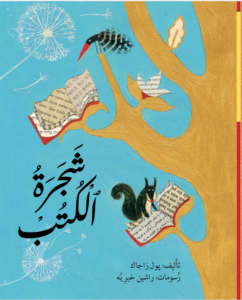 The book tree
The book tree 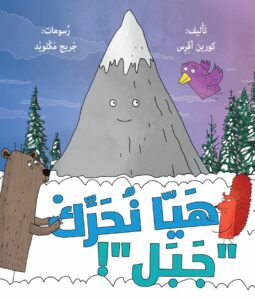 Move Mountain
Move Mountain 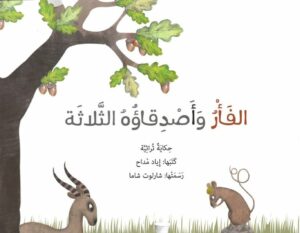 The Mouse and his Three Friends
The Mouse and his Three Friends 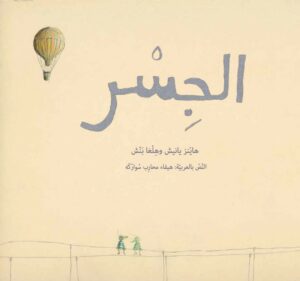 The Bridge
The Bridge 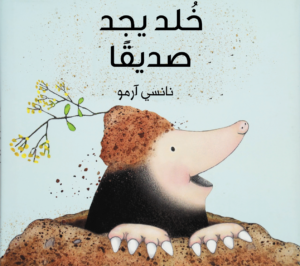 A Friend for Mole
A Friend for Mole 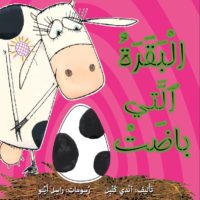 The Cow That Laid an Egg
The Cow That Laid an Egg 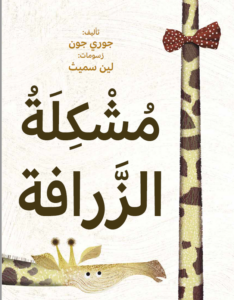 Giraffe Problems
Giraffe Problems 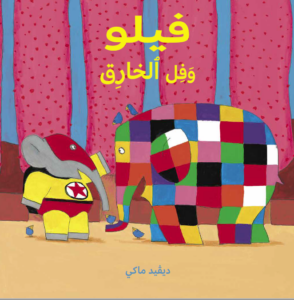 Filo and Super Phil
Filo and Super Phil 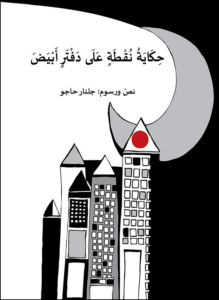 A Story of a Dot on a White Notebook
A Story of a Dot on a White Notebook 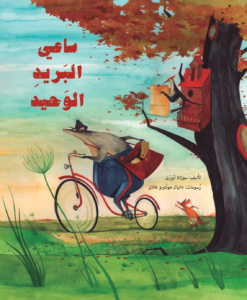 The Lonely Mailman
The Lonely Mailman 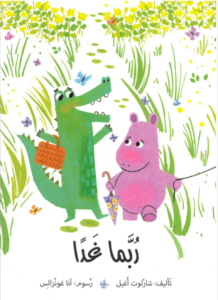 Maybe Tomorrow
Maybe Tomorrow 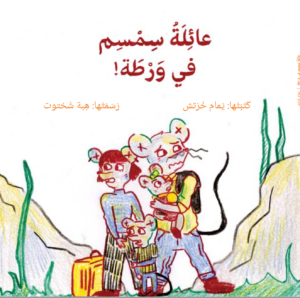 Simsim Family in Trouble
Simsim Family in Trouble 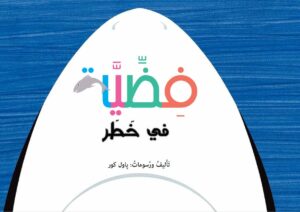 Caspion, Beware!
Caspion, Beware! 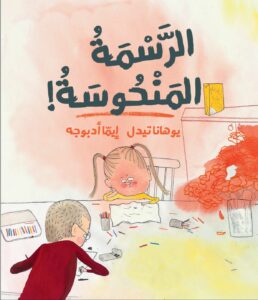 The misfortune drawing
The misfortune drawing 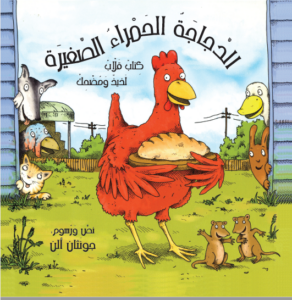 The Little Red Hen
The Little Red Hen 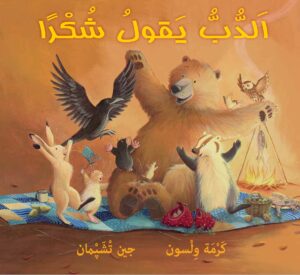 Bear says thanks
Bear says thanks 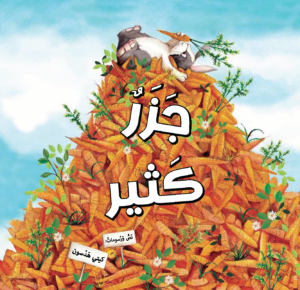 Too many carrots
Too many carrots 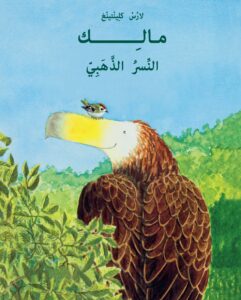 Malek, the Golden Eagle
Malek, the Golden Eagle  Oh Dear Geoffrey!
Oh Dear Geoffrey! 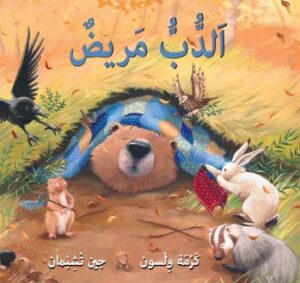 Bear Feels Sick
Bear Feels Sick  Soumsoum the Mouse (Al-far Soumsoum)
Soumsoum the Mouse (Al-far Soumsoum) 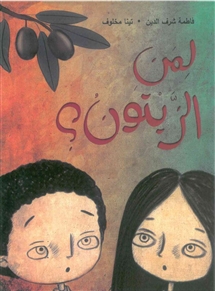 Whose Olives?
Whose Olives? 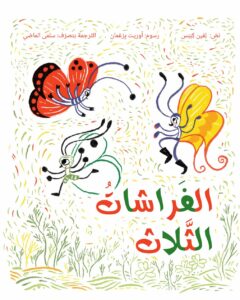 Three Butterflies
Three Butterflies 
